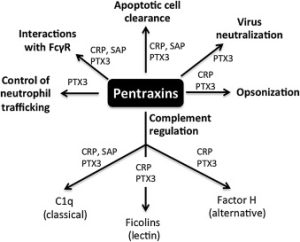 Pentraxins (PTX), are a family of proteins characterized by containing a pentraxin protein domain.
Pentraxins (PTX), are a family of proteins characterized by containing a pentraxin protein domain.
Pentraxin family proteins are involved in acute immunological responses, and are a class of pattern recognition receptors (PRRs).
They are a superfamily of multifunctional proteins, some of which are components of the humoral arm of innate immunity.
They behave as functional ancestors of antibodies.
They are known as classical acute phase proteins (APP).
They are characterized by their cyclic multimeric structure and are divided into two main groups based on their primary structure: short pentraxins and long pentraxins.
Short pentraxins include C-reactive protein (CRP) and serum amyloid P component (SAP).
These proteins are primarily produced in the liver in response to inflammatory mediators such as interleukin-6 (IL-6).
CRP and SAP are involved in recognizing a variety of pathogenic agents and damaged cells, facilitating their clearance through activation of the complement system and interaction with Fc gamma receptors on macrophages.
Long pentraxins, exemplified by pentraxin 3 (PTX3).
PTX3 is produced by various tissues and cells, particularly innate immunity cells, in response to proinflammatory signals and Toll-like receptor engagement.
PTX3 interacts with multiple ligands: growth factors, extracellular matrix components, and selected pathogens, and a role in complement activation, pathogen recognition, and modulation of inflammation.
PTX3 is also essential in female fertility, particularly in the assembly of the cumulus oophorus extracellular matrix.
Pentraxins function as soluble pattern recognition molecules that bridge innate and adaptive immunity by recognizing and binding to pathogens and damaged cells, thereby promoting their clearance and regulating inflammatory responses.
C-reactive protein is expressed during the acute phase response to tissue injury or inflammation.
The protein resembles antibody and performs several functions associated with host defense, promoting agglutination, bacterial capsular swelling and phagocytosis, and activates the classical complement pathway through its calcium-dependent binding to phosphocholine.
Pentraxin 3 (PTX3) is an acute phase protein whose levels rise during severe infections.
In case of central nervous system infections PTX3 helps distinguishes between bacterial and aseptic meningoencephalitis.
It is significantly higher in bacterial meningoencephalitis.
PTX3 is rapidly induced in response to interleukin-1 and TNF or microbial components in various cell types
These cell types are myelomonocytic cells (monocytes, macrophages, dendritic cells), vascular and lymphatic endothelial cells, and stromal cells.
Neutrophils synthesize PTX3 during myelopoiesis, store it in lactoferrin-positive granules, and rapidly release it after microbial recognition.
Pentraxins also bind to phospholipids and small nuclear ribonucleoproteins in apoptotic cells, promoting the disposal of these cells in a noninflammatory mode.
Thus, PTX3 differs from short pentraxins in terms of structure, cell source, and regulation.
Serum amyloid P component is found in all types of amyloid deposits, in glomerular basement membrane and in elastic fibers in blood vessels.
SAP binds to various lipoprotein ligands in a calcium-dependent manner.
Genes encoding proteins that contain this domain include:
APCS CRP GPR144 NPTX1; NPTX2; NPTXR PTX3 SVEP1
